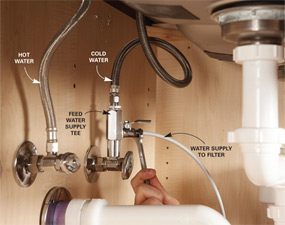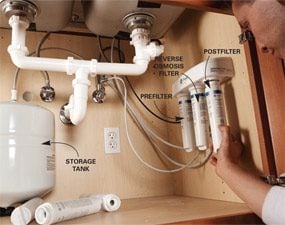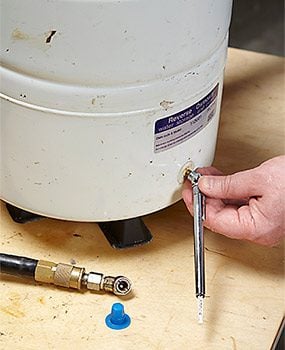Reverse osmosis water filter benefits, costs and performance
If you buy lots of bottled or filtered water or you’re worried about your tap water, a reverse-osmosis water filter can be a good investment. They can provide 10 or more gallons of drinking water a day. A reverse osmosis system costs from $150 to $300, plus $100 to $200 annually for replacement filters.
Reverse-osmosis filters remove many pollutants and chemicals, separating them from the water and then flushing them into the drain line. The purified water is then fed to the storage tank or the spout on the sink. However, reverse-osmosis filters remove the minerals that give water its taste, so try a gallon (available at most supermarkets) before buying a system.
Install a reverse osmosis system
First, hang the filter assembly on the back or side wall of the sink base (or in the basement close to the sink location) at the height specified in the instructions. Turn off both the cold and the hot water shutoffs, and then install (after the cold water shutoff) the tee or saddle valve included with the unit.
Cut the color-coded water supply line so that it’s above the cabinet base and won’t get kinked. Fasten the plastic tubing to the supply valve (Photo 1).
Shorten the supply and waste lines to the faucet to eliminate excess tubing, but don’t cut the larger black waste line yet. Attach the lines to the fittings on the base of the faucet (Photo 2). The black waste lines feed through the base of the faucet to keep them above possible sink backups, but they have no connection to the supply.
Fasten the faucet to the sink, then install the drain line adapter under the sink basket. Cut the waste line so that it flows downhill with no loops, then push it into the adapter (Photo 3).
Set the storage tank into place and install the final water line. Sterilize and fill the system according to the manufacturer’s instructions (Photo 4).
Recharge a reverse osmosis holding tank
If your reverse osmosis filtration system doesn’t deliver as much water as it did when it was new and you’ve changed the filters and membrane, the problem may be an undercharged or leaking holding tank. The tank uses a traditional tire valve-style stem that can lose air over time. When the air pressure drops, the bladder can’t push out as much water.
Here’s how to check the pressure. First, you’ll need a low-pressure tire gauge (one choice is the Victor Tire Gauge Low Pressure 1 to 20 psi; $6 at amazon.com). You can’t use an ordinary tire gauge. Next, turn off the water supply valve to the filter system and shut off the valve at the top of the holding tank. Disconnect the tubing at the tank valve. Dump all the water out of the tank. Then check the air pressure as shown above. Adjust to the recommended pressure. Then reinstall the tank and tubing and turn on the water.
Once the tank is filled, note the filled pressure. Wait a few days and check the pressure again. If the pressure is the same, you’re done. If the tank has lost pressure, try replacing the valve core (available at auto parts stores). If the new core doesn’t solve the problem, replace the tank.
Required Tools for this Project
Have the necessary tools for this DIY project lined up before you start—you’ll save time and frustration.
- 4-in-1 screwdriver
- Adjustable wrench
- Utility knife
Required Materials for this Project
Avoid last-minute shopping trips by having all your materials ready ahead of time. Here’s a list.
- low-pressure tire gauge
- reverse osmosis filter system
Article source here: Install a Reverse Osmosis Water Filter






No comments:
Post a Comment